|
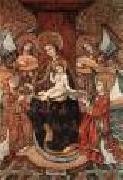 |
GARCIA, Pere
|
|
Spanish painter (active 1455-1479 in Barcelona) |
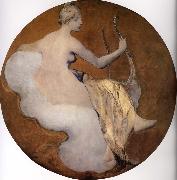 |
Galland Pierre Victor
|
|
Geneve 1822-Paris 1892
He studied metalwork with his father Jacques Galland, an accomplished goldsmith, until age 16. He then entered the studio of Henri Labrouste to study architecture. After two years of training, Labrouste encouraged him to pursue his interest in decorative painting under the direction of Michel-Martin Drolling. In 1843 the decorative painter Pierre-Luc-Charles Ciceri (1782-1868) hired Galland to assist with the painting of figures, flowers, garlands and fruit. He worked again with Labrouste, in 1848, on the decoration of the national festival, the F?te de la Concorde. |
 |
Gaetano previati
|
|
Italian Painter, 1852-1920
Italian painter and writer. He was one of the leading exponents of Divisionism, particularly skilled at large-scale decorative schemes, and especially important for his writings on technique and theory. |
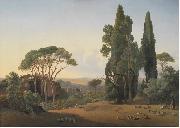 |
Fritz Petzholdt
|
|
(1 January 1805 - 29 August 1838) was a Danish landscape painter of the Copenhagen School, also known as the Golden Age of Danish Painting. He spent most of his artistic life in Italy, where he painted refined landscapes in a light colour palette but died early, most likely by way of suicide.
Fritz Petzholdt was born into a prosperous home on 1 January 1805 in Copenhagen to grocer Johan Jacob Petzholdt and his second wife Josephine Marie Elisabeth Petzholdt. After completing an apprenticeship as a house painter, he attended the Royal Danish Academy of Fine Arts from 1824 where he studied under Christoffer Wilhelm Eckersberg, known as the farther of the Golden Age of Danish Painting spanning the first half of the 19th century. He graduated in 1828 and already the following year sold a painting, En mose ved Høsterkøb med tørvearbejdere (A Bog at Høsterkøb), to the Royal Danish Painting Collection.
Although he never won the Academy's gold medal, the traditional opening for Academy students to go abroad to further their studies since it was accompanied by a travel stipend, his family's wealth allowed him to travel to Harz the same year and then, in May 1830, to set out for Rome. On the way he visited Dresden, Prague, Nuremberg, Munich, Venice and Florence. In Rome he joined the Danish artists colony which had formed in the city with Bertel Thorvaldsen as its centre. He made excursions to the Roman countrysideeto places such as Tivoli, Subiaco and Olevanoeas well as longer trips south to Naples, Sicily and Corfu.
In the winter of 1835/36 he returned to Copenhagen due to his farther's illness and subsequent death. Shortly after the funeral, he returned to Italy with an extended stop in Munich on the way. From Italy he continued to Greece, a destination only Martinus Rørbye had visited before him among the Danish Golden Age painters. On 29 August 1838 he was found dead in his hotel room in Patras with his throat cut. Whether it was a case of suicide or murder was never settled.
|
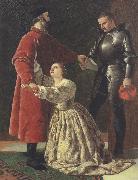 |
Frederick richard pickersgill,R.A.
|
|
1820-1900
was an English painter and book illustrator. Born into a family of artists, he was admitted to the Royal Academy Schools in 1840. He did some book illustrations for the works of John Milton and Edgar Allan Poe. Pickersgill's The Burial of Harold was accepted as a decoration for the Houses of Parliament in 1847. He also did some landscapes under the influence of the Pre-Raphaelites. In 1856 Pickersgill was photographed at 'The Photographed Institute' by Robert Howlett, as part of a series of portraits of 'fine artists'. |
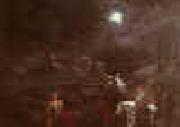 |
Franz Pforr
|
|
German
1788-1812
He received his earliest training from his father, the painter Johann Georg Pforr (1745-98), and his uncle, the art professor and first inspector of the painting gallery in Kassel, Johann Heinrich Tischbein the younger (1742-1808). In 1805 he became a student at the Akademie der Bildenden Kenste in Vienna, which was dominated by the severe Neo-classicism of its director, Heinrich Feger; he was taught by Hubert Maurer (1738-1818), Franz Cauzig (1762-1828) and Johann Martin Fischer. During the war with France in 1805, Pforr volunteered as a guard in the Vienna militia. He suffered a nervous breakdown, brought on by the conflict between his passionate longing for a contemplative life and a desire to see military action. He probably turned to religion to help sustain his mental equilibrium. In 1806 he resumed his academic studies and, believing himself destined to become a battle painter, made numerous drawings of historical battles, for example his still schoolish and baroquely composed Wallenstein in the Battle of L?tzen (1806; Frankfurt am Main, Stedel. Kstinst. & St?dt. Gal.). However, it was not until 1807, with Drawing with Twelve Travel Sketches (Frankfurt am Main, Stadt- & Ubib.), that he first began to overcome his beginner style and to develop his own. This resulted in reduced detail, simplified continuous contours, a structuring by means of planar rather than illusionistic criteria, a new clarity of vision and a chastened balance between nature and artistic conception.
|
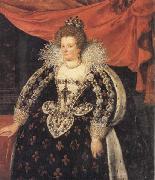 |
Frans Pourbus the younger
|
|
Flemish Baroque Era Painter, 1569-1622
was a Flemish painter, son of Frans Pourbus the Elder and grandson of Pieter Pourbus. He was born in Antwerp and died in Paris. He is also referred to as "Frans II". Pourbus worked for many of the highly influential people of his day, including the Brussels-based Spanish Regents of the Netherlands, the Duke of Mantua and Marie de' Medici, Queen of France. Works of his can be found in the Louvre, the Prado, the Rijksmuseum, the Royal College of Art, the Metropolitan Museum of Art and many other museums. |
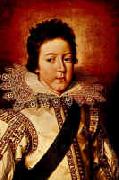 |
Frans Pourbus
|
|
Flemish Northern Renaissance Painter, ca.1545-1581
Painter, son of Pieter Pourbus. His work consists mainly of portraits and religious subjects, although he also executed a number of landscapes and history paintings. He worked mostly for the wealthy patrician class, and his work was instrumental in spreading the Romanism of Frans Floris (his teacher) throughout the Netherlands. It is probable that Frans Pourbus's earliest teaching was with his father in Bruges, but by 1564 he is recorded as working in the Antwerp studio of Floris. According to van Mander, Frans Pourbus and his fellow student Crispijn van den Broeck together completed an altarpiece by Floris after the latter's death in 1570. In 1566 Frans Pourbus married Susanna, a daughter of Cornelis Floris and niece of his master, and in 1569/70 he became a master in the Antwerp Guild of St Luke, though he retained his citizenship of Bruges. Gortzius Geldorp was his pupil in Antwerp in 1570. For Ghent Cathedral Frans painted Christ among the Doctors (the Viglius Altarpiece, 1571; in situ), which includes life-size portraits of Emperor Charles V, his son Philip, their secretary Viglius ab Aytta (d 1577), Jansenius, first Bishop of Ghent (d 1576), and the Duke of Alba. A decade later Pourbus executed the portrait of the Hoefnagel Family (c. 1581; Brussels, Mus. A. Anc.), shown grouped around a harpsichord playing musical instruments, in which the artist included a self-portrait (playing a lute) at the upper left. The picture was acquired in 1696 by Constantijn Huygens the younger from a cousin, a Hoefnagel descendant, in exchange for a horse; the young girl of 15 or 16 with a parrot in her hand was Huygens's grandmother. An inventory drawn up after Frans Pourbus death lists 20 portraits by him, many from the circle of the Duke of Anjou. |
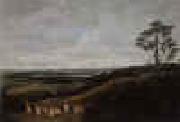 |
Frans Post
|
|
1612-1680 Dutch Frans Post Gallery
was a Dutch painter. He was the first European artist to paint landscapes of the New World.
In 1636 he traveled to Dutch Brazil at the invitation of Johan Maurits van Nassau-Siegen, who was governor-general there, at the suggestion of his brother Pieter Post. In 1644, Post returned to Haarlem. Of his Brazilian landscapes, some depict actual locations, while others are probably imaginary. Post's art is usually classified as Baroque. |
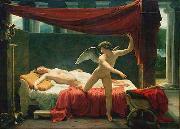 |
Francois-Edouard Picot
|
|
(10 October 1786 - 15 March 1868) was a French painter during the July Monarchy, painting mythological, religious and historical subjects.
|
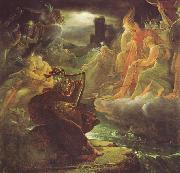 |
Francois Pascal Simon Gerard
|
|
12 March 1770 - 11 January 1837) was a French painter born in Rome, where his father occupied a post in the house of the French ambassador. His mother was Italian. As a baron of the Empire he is sometimes referred to as Baron Gerard. |
 |
Francois Pascal Simon Gerard
|
|
François Pascal Simon, Baron Gerard (12 March 1770 - 11 January 1837) was a French painter born in Rome, where his father occupied a post in the house of the French ambassador. His mother was Italian. As a baron of the Empire he is sometimes referred to as Baron Gerard.
|
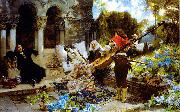 |
Francisco Pradilla Ortiz
|
|
(July 24, 1848 - November 1, 1921) was a prolific Spanish painter famous for creating historical scenes.
He was born in Villanueva de Gellego, near Zaragoza in Aragon, and studied initially in Zaragoza and then transferred to the Real Academia de Bellas Artes de San Fernando and the Academia de Acuarelistas in Madrid. In 1873, he won a scholarship to go to Rome. From there he had opportunities to travel to France and Venice and studied the old masters. In 1878 he submitted his painting Doña Joanna of Castile or (Juana la Loca) to the National Exhibition in Spain and was awarded the Medal of Honor. The Spanish Senate then commissioned him to create La Rendicien de Granada (The Surrender of Granada) that took him three years to complete (1882). In 1881 he became the Director of the Spanish Arts Academy in Rome, but resigned from this post after two years. He traveled, mostly in Italy, portraying local themes and people. In 1897 he returned to Madrid as the director of the Museo del Prado. He held this position only briefly and then focused again on painting.
His total output is well over 1,000 paintings showing his interest in a variety of subjects and styles, often without regard of the current fashion. He is primarily recognized for his historical paintings, the last one completed in 1910 carries one of the longer titles of a major painting, Cortejo del bautizo del Prencipe Don Juan, hijo de los Reyes Catelicos, por las calles de Sevilla (Retinue of the Baptism of Don Juan, son of the Catholic Monarchs, Along the Streets of Seville). Much more common, however, are costumbristaseoften romanticized studies that show local customs or mannerseand landscapes that are often sketchy, with impressionistic influences. Financial duress after the bankruptcy of his bank may have imposed a special need to be productive.
He died in Madrid in 1921 at the age of 73.
|
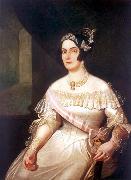 |
Francisco Pedro do Amaral
|
|
Amaral, Francisco Pedro do (1790 - 1831)
painted Portrait of Domitila de Castro Canto e Melo, Marquise of Santos in 19th century
|
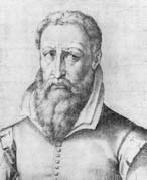 |
Francisco Pacheco
|
|
Spanish painter, teacher, and schola
1564-1644, Spanish painter and writer. He is not considered to be a great painter, but he is remembered for his theoretical work Arte de la pintura. The book is the most important contribution to Spanish artistic theory in the 17th century.
|
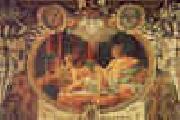 |
Francesco Primaticcio
|
|
Italian 1504-1570 Francesco Primaticcio Gallery
Born in Bologna, he trained under Giulio Romano in Mantua and became a pupil of Innocenzo da Imola, executing decorations at the Palazzo Te before securing a position in the court of Francis I of France in 1532.
Together with Rosso Fiorentino he was one of the leading artists to work at the Chateau Fontainebleau (where he is grouped with the so-called "First School of Fontainebleau") spending much of his life there. Following Rosso's death in 1540, Primaticcio took control of the artistic direction at Fontainebleau, furnishing the painters and stuccators of his team, such as Nicol?? dell'Abate, with designs. He made cartoons for tapestry-weavers and, like all 16th-century court artists, was called upon to design elaborate ephemeral decorations for masques and f??tes, which survive only in preparatory drawings and, sometimes, engravings. François trusted his eye and sent him back to Italy on buying trips in 1540 and again in 1545. In Rome, part of Primaticcio's commission was to take casts of the best Roman sculptures in the papal collections, some of which were cast in bronze to decorate the parterres at Fontainebleau.[1]
Primaticcio retained his position as court painter to François' heirs, Henri II and François II. His masterpiece, the Salle d'Hercule at Fontainebleau, occupied him and his team from the 1530s to 1559.
Primaticcio's crowded Mannerist compositions and his long-legged canon of beauty influenced French art for the rest of the century.
Primaticcio turned to architecture towards the end of his life, his greatest work being the Valois Chapel at the Abbey of Saint-Denis, although this was not completed until after his death and was destroyed in 1719. |
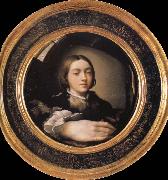 |
Francesco Parmigianino
|
|
1503 ~ 1540,Italian painter, draughtsman and printmaker. Beginning a career that was to last only two decades, he moved from precocious success in the shadow of Correggio in Parma to be hailed in the Rome of Clement VII as Raphael reborn. There he executed few large-scale works but was introduced to printmaking. After the Sack of Rome in 1527, he returned to northern Italy, where in his final decade he created some of his most markedly Mannerist works. Equally gifted as a painter of small panels and large-scale frescoes both sacred and profane, he was also one of the most penetrating portrait painters of his age. Throughout his career he was a compulsive draughtsman, not only of preparatory studies for paintings and prints, but also of scenes from everyday life and of erotica. |
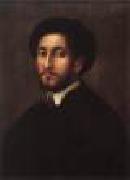 |
FOSCHI, Pier Francesco
|
|
Italian painter, Florentine school (b. 1502, Firenze, d. 1567, Firenze)
was an Italian painter active in Florence in a Mannerist style. He was pupil of Andrea del Sarto and assisted Pontormo with his frescoes at Careggi in 1536. He completed 3 altarpieces, commissioned in 1540C1545 for the church of Santo Spirito in Florence: an Immaculate Conception, Resurrection , and a Transfiguration. Foschi was also influenced by and Il Bronzino. One of his pupils was Alessandro Fei. Also called Pier Francesco di Jacopo Foschi or Toschi. He was the son of Pierfrancesco di Jacopo Sandro Foschi, known for his Madonna and Child with the Infant Saint John. (Utah Museum of Fine Arts). Foschi is best noted for his portraits painted between 1530 and 1540, including his Portrait of a Lady (Museo Thyssen-Bornemisza), Portrait of a Young Man Weaving a Wreath of Flowers (Utah Museum of Fine Arts), and his Portrait of a Man, (Uffizi Gallery). In his portraits he adhered to Mannerist style, utilizing a slight Contrapposto in the sitter with their head turned from the body. This pose gave the depiction a spontaneity and sense of movement for the innovative Mannerists, but was eventually so formulaic that it lost its intention of originality. |
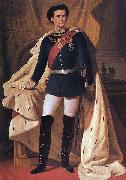 |
Ferdinand von Piloty
|
|
painted King Ludwig II of Bavaria in generals' uniform and coronation robe in 1865 |
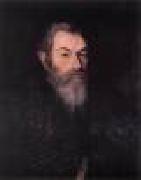 |
FARINATI, Paolo
|
|
Italian painter, Veronese school (b. 1524, Verona, d. 1606, Verona)
Italian painter and draughtsman. He was the son of a painter, Giambattista, but probably trained in the workshop of Nicola Giolfino (Vasari). His earliest documented painting, St Martin and the Beggar (1552; Mantua Cathedral), was commissioned by Cardinal Ercole Gonzaga along with works by Battista dell'Angolo del Moro, Veronese and Domenico Brusasorci for Mantua Cathedral, newly restored by Giulio Romano. As is evident in his chiaroscuro and figure types, Farinati had absorbed certain Mannerist influences from the frescoes of scenes from the Life of the Virgin (1534) in the choir of Verona Cathedral, executed by Francesco Torbido to Giulio's design. Giolfino's eccentric style would also have encouraged Farinati to emphasize line over colour and to restrict his palette to rather opaque greys, browns, mauve and rust. His two-canvas Massacre of the Innocents (1556; Verona, S Maria in Organo) displays the muscular figures, sharp foreshortenings and posed attitudes of Mannerism and has a more polished finish than his earlier work. Its strong, plastic qualities are also evident in Christ Walking on the Water and the Supper of St Gregory (1558) in the choir of the same church. |
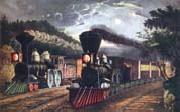 |
Fanny Palmer
|
|
One of the premier artists and stone lithographers .
American , 1812-1876
|
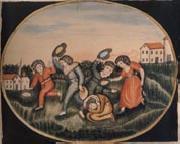 |
Eunice Pinney
|
|
American Folk Artist, 1770-1849
She was a self-taught artist who, from about 1809 to 1826, devoted part of her time to producing a wide range of subjects in watercolour: landscape, genre, historical, biblical, allegorical and literary. Her distinctive style is solid and robust, with a strong sense of contrast and design. Problems in creating realistic form are apparent: faces are largely expressionless, and figures are stocky and two-dimensional. However, these difficulties are compensated for by fresh vigorous colour, bold pattern, artful composition and varied subject-matter. Pinney displayed the primitive artist's tendency to borrow and model from the best sources at hand: The Cotter's Saturday Night |
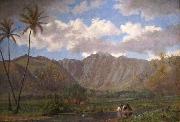 |
Enoch Wood Perry, Jr.
|
|
(1831-1915) was a painter from the United States.
Perry was born in Boston on July 31, 1831. His father was Enoch Wood Perry, and mother was Hannah Knapp Dole. His maternal grandparents were Samuel Dole and Katherine Wigglesworth. The family moved to New Orleans with his family as a teenager in 1848 and attended its public schools. After working several years as a clerk in a commission house, Perry began formal art education. In 1852 he went to Europe for four years and studied with Emanuel Leutze at the Desseldorf Academy, Thomas Couture in Paris, and in Rome.Perry served as the U.S. Consul to Venice between 1856 and 1858. Upon returning to America, he opened a studio in Philadelphia. |
 |
Eilif Peterssen
|
|
1852-1928
was a Norwegian painter. He attended the of Fredrik Eckersberg in Kristiania (now Oslo) in 1866 and 1870. After that, he studied painting briefly with Knud Bergslien at the Johan Fredrick Eckersberg School of Painting and left to go abroad in 1871. He studied at the School of Art of Copenhagen; in Karlsruhe (1871?C1873), where he was a student of Hans Gude; and, together with Hans Heyerdahl, in Munich under Wilhelm von Diez. He then studied in London, Paris, and Italy. After these travels, he returned to Norway and settled in Bærum. He made his debut at the Høstutstillingen (Autumn Exposition) in Kristiania in 1882. He was a profound connoisseur of European art and was later associated groups such as Lysaker, the painters of Fleskum and those of Skagenpainters, as well as with individual artists like August Eiebakke, Kitty Kielland and Harald Oskar Sohlberg. In Norway, he is also known as the designer of the coat of arms of Norway, adopted when the country separated from Sweden in 1905 to become an independent country. This version was used for official government purposes until 1937, when it was replaced by a new version. Nonetheless, Peterssen's design is still used for the royal coat of arms and for the royal flag. In addition to his canvasses, he collaborated on the decoration of the Tourist Hotel in Holmenkollen in 1889. In the same year, he painted the murals "The Wanderers of Emmaus" in the Church of Tanum in Bærum and "Jesus in the Garden of Gethsemane" in the Church of the Cross, Bergen. |
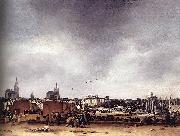 |
Egbert van der Poel
|
|
Egbert van der Poel (Delft, 1621 - Rotterdam, 1664) was a Dutch Golden Age genre and landscape painter, son of a Delft goldsmith.
He may possibly have been a student of Esaias van de Velde and of Aert van der Neer. According to the RKD he was the brother of the painter Adriaen Lievensz van der Poel and a student of Cornelis Saftleven in Rotterdam. Van der Poel was registered with the Guild of St Luke in Delft on October 17, 1650, where he is listed as a landscape painter. In 1651 van der Poel married Aeltgen Willems van Linschooten in Maassluis, near Rotterdam. His most famous paintings depict the Delft gunpowder explosion of October 12, 1654 and its aftermath; he and his wife were living in the area at the time. Egbert and Aeltgen van der Poel had a son and three daughters. He died in Rotterdam in 1664. |
 |
Edward Henry Potthast Prints
|
|
American Impressionist Painter, 1857-1927
Edward Henry Potthast (1857 ?C 1927) was an American Impressionist painter.
He was born in Cincinnati, Ohio. From June 10, 1879 to March 9, 1881 he studied with Thomas Satterwhite Noble. He later studied at the Royal Academy in Munich with the American-born instructor Carl Marr. After returning to Cincinnati in 1885 he resumed his studies with Noble. In 1886 he departed for Paris, where he studied with Fernand Cormon. In 1895 he relocated to New York City and remained there until his death in 1927. |
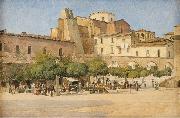 |
Edvard Petersen
|
|
(4 February 1841 - 5 December 1911) was a Danish painter. He also designed the Stork Fountain on Amagertorv in Copenhagen
From 1851 he attended the Royal Danish Academy of Fine Arts. In the 1860s and 1870s he painted romantic landscape paintings under influence of Vilhelm Kyhn. He was a close friend of fellow painter Theodor Philipsen and together they went on several travels, including two stays in Italy between 1875 and 1880 and a visit to France.The friendship did not seem to influence Petersen's rather conservative style of painting and his works from the times abroad are generally traditional paintings of local life.
In the 1880s Petersen painted a number of figure paintings of street life in Copenhagen under influence of French Realism. His most famous paintings are Emigrants on Larsens Plads (1880) and A Return, the America Liner at Larsens Plads (894).
With his Stork Fountain proposal, Petersen won the competition for the design of a new fountain on Amagertorv in Copenhagen in 1888. The sculptor Vilhelm Bissen moulded the birds and the fountain was inaugurated in 1904
|
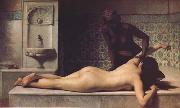 |
Edouard Debat Ponsan
|
|
French Academic Painter, 1847-1913
1847-1913.French painter. He trained in Toulouse and later at the Ecole des Beaux-Arts in Paris under Alexandre Cabanel. In 1873 he won second place in the Prix de Rome and in 1874 the Prix Troyon of the Institut. From the Institut he received a bursary that enabled him to visit Italy. In 1870 he made his debut at the Salon under the name Ponsan-Debat and afterwards exhibited there such genre and history paintings as Jephthah's Daughter (1876; Carcassonne, Mus. B.-A.). He also executed religious works, some of which were for churches and cathedrals: he painted St Paul before the Areopagus (1877) for the church at Courbevoie and the Pity of St Louis for the Dead (1879) for the cathedral at La Rochelle. From 1880 Debat-Ponsan was the name under which he exhibited. The Massage (1883; Toulouse, Mus. Augustins) shows a white female nude massaged by a negress, and the subject attracted comment from contemporary critics. He also painted a number of landscapes, including Corner of the Vineyard (1888; Nantes, Mus. B.-A.). These were painted in a style similar to that of Jules Bastien-Lepage and, when they included figures, were often sentimental. His reputation depended, however, on his portraits, which are distinguished by their vigorous colour and precision, as seen in the portrait of Pouyer-Quertier (c. 1885; Rouen, Mus. B.-A.). Most notable was his portrait of General Boulanger (1887; untraced), which was shown at the Salon of 1887 and was accepted in 1889 for the Exposition Universelle in Paris. Amid scandal, Debat-Ponsan withdrew it soon after the opening because he thought that the Exposition was badly organized and his painting was not shown to advantage. He refused the bronze medal awarded it by the jury. In later years, while producing such paintings as Christ on the Mountain (1889; Toulouse, Mus. Augustins), he increasingly responded to contemporary events in his work. |
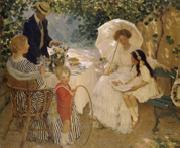 |
E.Phillips Fox
|
|
Australian Naturalist Painter, 1865-1915
Australian painter and teacher. From 1878 to 1886 he trained at the National Gallery of Victoria Art Schools, Melbourne, and in 1887 left to study in Europe. In Paris he attended the Academie Julian and was taught by Jean-Leon Gereme at the Ecole des Beaux-Arts and by the American artist T. Alexander Harrison (1853-1930). He was involved with the plein-air artists at Etaples, Pas-de-Calais, and in Brittany and also visited Giverny, where from 1883 Monet was living. By 1890 he had moved to England, to the artists' colony at St Ives, Cornwall. In 1892 he returned to Melbourne where he chiefly painted portraits and landscapes. He was a member of the Victorian Artists' Society, exhibiting with them between 1892 and 1900. In 1893 he established the lively Melbourne Art School with Tudor St George Tucker (1862-1906). There an academic training coupled with a modified Impressionist technique was taught, as can be seen in Fox's painting the Art Students . In 1901 he left for London, having been commissioned by the Trustees of the National Gallery of Victoria to paint the Landing of Captain Cook at Botany Bay. After his marriage in 1905 to the artist Ethel Carrick, he and his wife settled in Paris and remained there until 1913. |
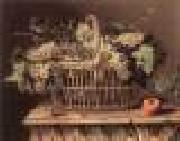 |
DUPUYS, Pierre
|
|
French painter (b. 1610, Montfort l'Amaury, d. 1682, Paris).
|
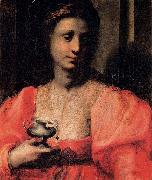 |
Domenico Puligo
|
|
(1492-1527) was an Italian painter of the Renaissance, active in Florence. His real name was Domenico di Bartolommeo Ubaldini.
He was trained by Ridolfo Ghirlandaio, but acquired a style consistent with his contemporary Andrea del Sarto. He painted a Vision of Saint Bernard altarpiece, now in Walters' Gallery in Baltimore. He was also in demand for portraits. He is featured in Giorgio Vasari's Vite or biographies of artists. He excelled as a portrait painter. He befriended Andrea del Sarto ane worked with Ridolfo Ghirlandaio. His brother, Jacone Puligo was also a Renaissance painter.
|
 |
Domenico di Pace Beccafumi
|
|
(1486?CMay 18, 1551) was an Italian Renaissance-Mannerist painter active predominantly in Siena. He is considered one of the last undiluted representatives of the Sienese school of painting.
Domenico was born in Montaperti, near Siena, the son of Giacomo di Pace, a peasant who worked on the estate of Lorenzo Beccafumi. Seeing his talent for drawing, Lorenzo adopted him, and commended him to learn painting from Mechero, a lesser Sienese artist. In 1509 he traveled to Rome, but soon returned to Siena, and while the Roman forays of two Sienese artists of roughly his generation (Il Sodoma and Peruzzi) had imbued them with elements of the Umbrian-Florentine Classical style, Beccafumi's style remains, in striking ways, provincial. In Siena, he painted religious pieces for churches and of mythological decorations for private patrons, only mildly influenced by the gestured Mannerist trends dominating the neighboring Florentine school. |
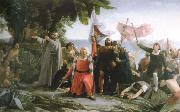 |
dioscoro teofilo puebla tolin
|
|
dioscoro teofilo puebla tolin(1831 to1901),who studied in madrid and rome,worked in the tradition fo historicism,asubgenre of history painting,which focused on the interplay of religious pride,patriotism ,and sntions of glory.tolin s technical style is referred to as eclecticism for its wide ranging,and often superficial ,borrowing from euopean techniques and visual trends. paintings in this genre were often funded by official organizations and art academies,which treated them as opportuities for propagandistic interpretations of history.the first landing of christopher columbus in america provides on shortage of drama |
|

